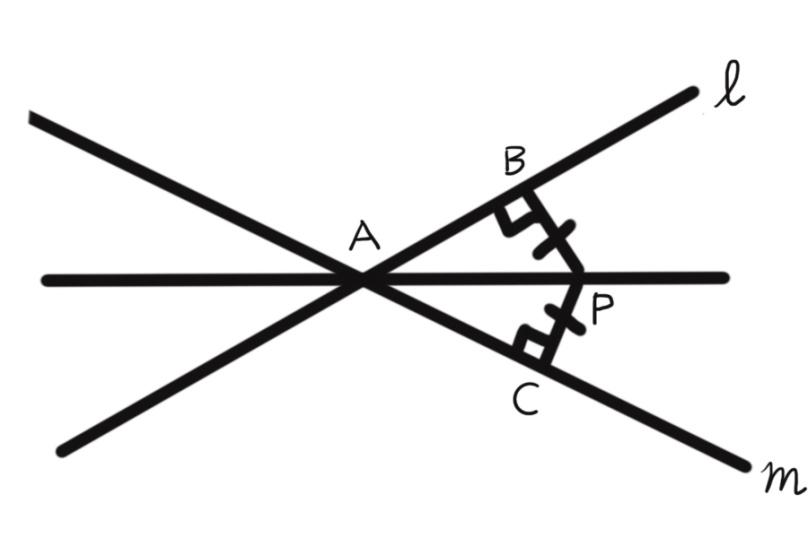
$P$ is a point equidistant from two lines $l$ and $m$ intersecting at point $A$. Show that the line $AP$ bisects the angle between them.


Answer
575.1k+ views
Hint: Notice that there are two right angled triangles in the diagram, $ABP$ and $ACP$. Start the solution by trying to prove that both are congruent to each other. For doing that you can use the HL(Hypotenuse-Leg) hypothesis. Once you have done that, you can easily show that $\angle BAP = \angle PAC$.
Complete step-by-step answer:
We can prove that $AP$ bisects the angle between $l$ and $m$ if we can show that the triangles $ABP$ and $ACP$ are congruent to each other. Notice that both these triangles are right angled triangles. And to prove congruence between two right angled triangles we use the HL(Hypotenuse-Leg) convention which states that that if the length of the hypotenuse and one of the other two legs of two right angled triangles are equal, then they are congruent to each other.
In the figure, it is shown that $AB = AC$. And we can also see that the hypotenuse $AP$ is common to both. That implies that both have the same length hypotenuse. Therefore, these two triangles are congruent by the HL hypothesis.
Now, we know that congruent triangles have equal sides and equal angles. Therefore, $\angle BAP = \angle PAC$ . This proves that $AP$ bisects the angle between $l$ and $m$.
Note: Remember that the HL(Hypotenuse-Leg) hypothesis is applicable only for right angled triangles. To tackle these sorts of problems, always start by proving that the two triangles are congruent. Once that is proven, you can easily show that the angle is bisected by the line because bisection of an angle basically means that we have to prove that the angle on both sides of the line are equal.
Complete step-by-step answer:
We can prove that $AP$ bisects the angle between $l$ and $m$ if we can show that the triangles $ABP$ and $ACP$ are congruent to each other. Notice that both these triangles are right angled triangles. And to prove congruence between two right angled triangles we use the HL(Hypotenuse-Leg) convention which states that that if the length of the hypotenuse and one of the other two legs of two right angled triangles are equal, then they are congruent to each other.
In the figure, it is shown that $AB = AC$. And we can also see that the hypotenuse $AP$ is common to both. That implies that both have the same length hypotenuse. Therefore, these two triangles are congruent by the HL hypothesis.
Now, we know that congruent triangles have equal sides and equal angles. Therefore, $\angle BAP = \angle PAC$ . This proves that $AP$ bisects the angle between $l$ and $m$.
Note: Remember that the HL(Hypotenuse-Leg) hypothesis is applicable only for right angled triangles. To tackle these sorts of problems, always start by proving that the two triangles are congruent. Once that is proven, you can easily show that the angle is bisected by the line because bisection of an angle basically means that we have to prove that the angle on both sides of the line are equal.
Recently Updated Pages
Master Class 7 Maths: Engaging Questions & Answers for Success

Class 7 Question and Answer - Your Ultimate Solutions Guide

Master Class 12 Economics: Engaging Questions & Answers for Success

Master Class 12 Maths: Engaging Questions & Answers for Success

Master Class 12 Biology: Engaging Questions & Answers for Success

Master Class 12 Physics: Engaging Questions & Answers for Success

Trending doubts
Convert 200 Million dollars in rupees class 7 maths CBSE

What are the controls affecting the climate of Ind class 7 social science CBSE

List of coprime numbers from 1 to 100 class 7 maths CBSE

Write a letter to the editor of the national daily class 7 english CBSE

Fill in the blanks with appropriate modals a Drivers class 7 english CBSE

Repeated addition of the same number is called a addition class 7 maths CBSE





